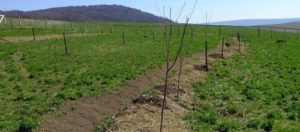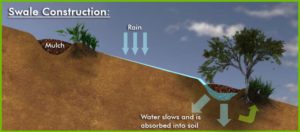A swale is quite simply a ditch & downhill mound (also known as a berm) dug on a contour. It can be anything from 5 feet to 5 kilometres long. Swales collect water during and after rainfall, allowing for a slow and consistent drainage of water into an area.
Over time this collects silt and surface nutrients, creating a moist, fertile location for growing trees and other plants.
Swales can be used to channel water run-off from roads, yards and car parks or they can be used to move water through a site.
Swales can follow contour or have an incline up to 6 degrees depending local conditions. The easiest way to establish a contour line in your orchard or pastures is to use a rotary laser level – these are expensive to purchase but can be hired out easily enough. For a comprehensive how-to, see Rotary Laser Level How-to
For other contouring methods, see Simple surveying techniques
There are a few things to keep in mind when installing a swale
- During very heavy rainfall, swales can overflow. If flash floods are a possibility, and to avoid erosion – you should include a rock-lined spillway to a lower swale, drainage ditch or catchment dam.
- Pools of water in the swales may result in mosquitos in warmer climates, it is recommended to mulch in the swale to reduce standing water. Also, planting of water loving ground covers help to stabilise the soil and absorb excess water
- Swales can be adapted to almost any environment but may not be appropriate for areas with a high water table or on extremely steep slopes.
- Swales are most suited for deep rooted perennial plant species, trees, bushes & nitrogen fixing ground covers where regular access for maintenance or harvesting is not required
Common species to plant on swales
- Fruit & nut trees
- Windbreak trees
- Berry bushes (gooseberry, gojiberry, blackberry, etc)
- Comfrey
- Peas, beans, peanuts
- Root vegetables – sweet potatoes are especially productive in swale conditions
[ess_grid alias=”swalegrid”]



